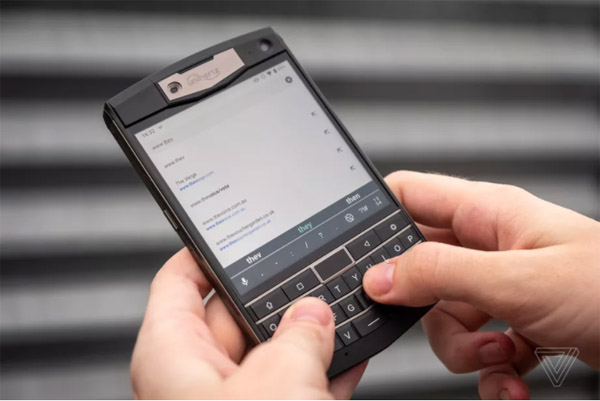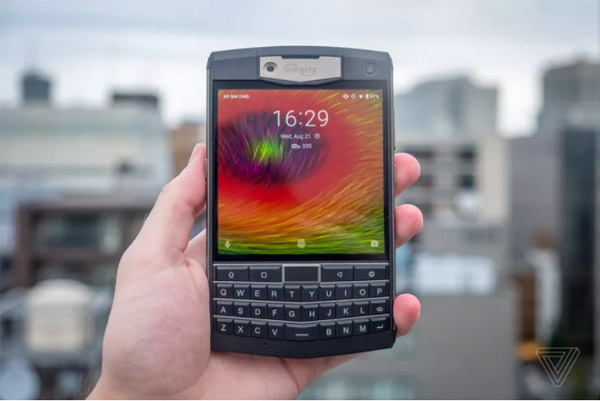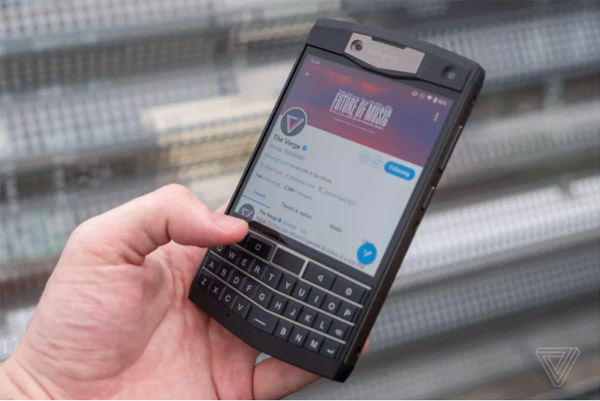
Are you the fast-talking, fast-emailing CEO of a construction firm who occasionally needs to visit building sites? Are you a hotshot Wall Street trader who is terrified of getting lost in the woods? Are you presently on an oil rig, and you want to write a novel on a pocket-sized device? If the answer to any of these questions is “yes,” then wow, does Unihertz have the phone for you.
If the answer to all of them is “no,” then, well, maybe not. But that doesn’t stop this prerelease Unihertz Titan from being one of the most delightfully weird phones I’ve used all year.
Unihertz is a small Chinese company whose previous phones, the Jelly and the Atom, were tiny Android devices with 2.45-inch screens that are designed for situations where you don’t need a full-on flagship phone in your pocket. The Titan could not possibly be more different. It’s a huge, industrially fortified phone with a massive battery, a large square screen, and yes, a physical keyboard.


In other words, it’s more or less a rugged BlackBerry Passport that’s running Android 9.0. The Titan doesn’t have the Passport’s sleek lines, but it doesn’t make a secret of its inspiration either. The 4.6-inch 1430 x 1438 screen is roughly the same size and resolution, and the three-line keyboard uses an identical layout — albeit with a pointed, slightly Bold-influenced curve.
This is a chunky phone. It fits into my jeans pocket, but I don’t ever forget it’s there. The Titan is 16.65mm thick; it has IP67 water, dust, and shock protection; and it weighs a comical 303g (which is about 50 percent more than a typical large phone, like a Galaxy Note 10 Plus or the iPhone XS Max). That is at least partially accounted for by the inclusion of a gigantic 6,000mAh battery. You also get USB-C, wireless charging, and a headphone jack.
Honestly, I really enjoy holding the Titan in my hands. It is so unavoidably, intentionally mammoth that you can’t help but feel ready to Get Things Done. Part of that is due to the sheer width of the thing. Even more so than today’s large flagship phones, you simply cannot use the Titan one-handed. You need to hold it in both hands and use the keyboard with both of your thumbs for it to make any sense at all. It’s not a casual device.


I’m not someone who mourned the loss of physical phone keyboards, and I am much slower typing on the Titan than I would be on almost any other smartphone. For what it is, though, the keyboard feels pretty good, and I think people who miss that tactility will be happy. It also lifts the BlackBerry Passport’s touch sensitivity so that you can scroll through apps without obscuring the screen, which is a neat feature.
My biggest complaint is that the capacitive home button / fingerprint reader is the only key that doesn’t physically depress. It’s jarring to have to push the surrounding buttons in, and I constantly found myself pressing too hard on the home button. The backlighting is also very uneven, with a cheap-looking falloff in brightness for the more central keys.
The screen, on the other hand, looks great. Viewing angles aren’t its strong point, but the colors are punchy and the resolution is incredibly sharp at 440 non-PenTile ppi. More importantly, the huge lateral width means that a lot of content fits really well. Anything with more than a couple of paragraphs of text, like an article on the web or a Kindle book, feels much more comfortable to read on the Titan than on a regular phone. It also works great with Slack, which feels like an important use case for a phone like this.
That said, the experience of using the Titan does fall down in some obvious ways. Android’s greatest strength is its versatility, but app makers could be forgiven for not targeting massive square screens, and that’s something you’ll run into pretty often when using the Titan. Anything based around vertical scrolling, like Twitter, shows barely any content at once; video apps invariably require you to turn the phone sideways for full-screen content that doesn’t get any bigger; and Pokémon Go adopts a weird ultrawide-angle view that makes pokémon look like they’re miles away. Nothing that I regularly use is completely broken on the Titan, but a good amount of it feels impractical.


In many of the regards in which we would be concerned when reviewing any other phone, the Unihertz Titan is a bad phone. The camera is garbage. Performance from the Helio P60 chip isn’t great. It can’t even display Instagram Stories without cropping off the top and bottom.
But if you know you want it, you know you want it. The BlackBerry Passport was an ultra-niche device, and it came out more than five years ago. Current BlackBerry license holder TCL seems to be more interested in producing comparatively sleek phones like the Key2, so it falls to the likes of Unihertz to produce bizarre — yet oddly compelling — devices like the Titan.
It costs $259 on Kickstarter right now (Unihertz says the Titan will be $359 when it exits crowdfunding), so I feel like the price has to be right for someone. Unihertz says the Titan is aimed at “working professionals, outdoor enthusiasts, and QWERTY lovers.” I’m not quite sure its appeal is that broad, given the serious caveats mentioned above. But if you tick all three boxes, it could well be worth thinking about.
